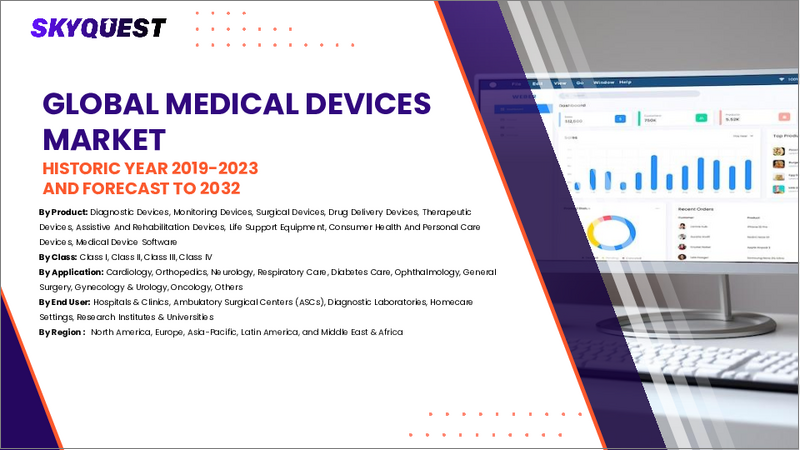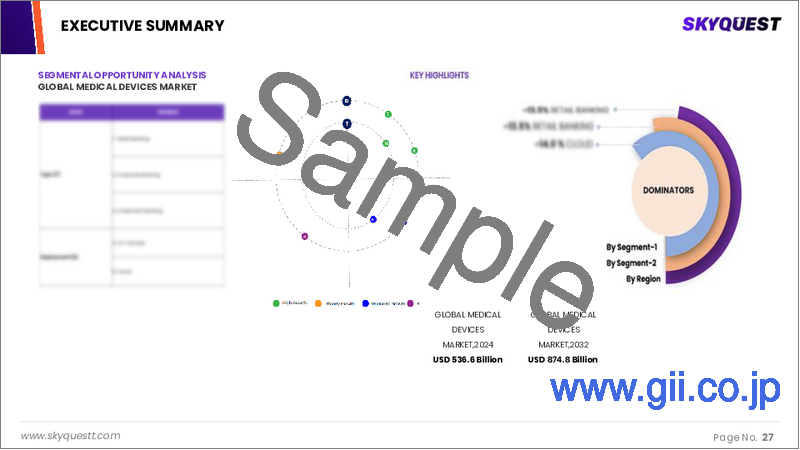|
|
市場調査レポート
商品コード
1690057
医療機器市場規模、シェア、成長分析:機器タイプ別、用途別、エンドユーザー産業別、地域別 - 産業予測 2025~2032年Medical Devices Market Size, Share, and Growth Analysis, By Type of Device (Respiratory Devices, Cardiology Devices), By Application (Medical Imaging, Remote Patient Monitoring), By End-user Industry, By Region - Industry Forecast 2025-2032 |
||||||
|
|||||||
| 医療機器市場規模、シェア、成長分析:機器タイプ別、用途別、エンドユーザー産業別、地域別 - 産業予測 2025~2032年 |
|
出版日: 2025年03月21日
発行: SkyQuest
ページ情報: 英文 157 Pages
納期: 3~5営業日
|
- 全表示
- 概要
- 目次
医療機器の世界市場規模は、2023年に5,170億米ドルと評価され、2024年の5,454億3,000万米ドルから2032年には8,370億7,000万米ドルに成長し、予測期間中(2025-2032年)のCAGRは5.5%で成長する見通しです。
医療機器市場は、舌圧子やベッドパンといった単純なものから、プログラマブルペースメーカーや義肢といった複雑な機器まで、多様な製品群によって特徴付けられます。この分野には、妊娠検査薬や血糖値測定器などの体外診断(IVD)製品も含まれ、健康に関連する電子機器と定義される医療機器の広範な範囲を際立たせています。生化学的に機能する医薬品とは異なり、医療機器は機械的な手段で作動するため、患者の安全性を確保するために厳しい規制監視が必要となります。医療技術の進歩に伴い、低侵襲手術、遠隔医療、個別化治療の動向に後押しされ、革新的な機器に対する需要は増加傾向にあります。その結果、規制機関はこれらの技術の有効性と安全性を維持する上で重要な役割を果たしています。
目次
イントロダクション
- 調査の目的
- 調査範囲
- 定義
調査手法
- 情報調達
- 二次と一次データの方法
- 市場規模予測
- 市場の前提条件と制限
エグゼクティブサマリー
- 世界市場の見通し
- 供給と需要の動向分析
- セグメント別機会分析
市場力学と見通し
- 市場概要
- 市場規模
- 市場力学
- 促進要因と機会
- 抑制要因と課題
- ポーターの分析
主な市場の考察
- 重要成功要因
- 競合の程度
- 主な投資機会
- 市場エコシステム
- 市場の魅力指数(2024年)
- PESTEL分析
- マクロ経済指標
- バリューチェーン分析
- 価格分析
- 技術分析
- ケーススタディ
- 顧客と購買基準の分析
医療機器市場規模:機器タイプ別& CAGR(2025-2032)
- 市場概要
- 呼吸器
- 心臓病用機器
- 整形外科用機器
- 画像診断装置
- 体外診断装置
- 内視鏡装置
- 眼科用機器
- 腎臓用機器
- 糖尿病用機器
- その他の機器
医療機器市場規模:用途別& CAGR(2025-2032)
- 市場概要
- 医療画像
- 遠隔患者モニタリング
- 自己診断
- 予防ケア
- 創傷ケア
- 手術
- その他の用途
医療機器市場規模:エンドユーザー産業別& CAGR(2025-2032)
- 市場概要
- 病院
- クリニック
- ホームケア
- 外来手術センター
- 診断センター
医療機器市場規模:地域別& CAGR(2025-2032)
- 北米
- 米国
- カナダ
- 欧州
- ドイツ
- スペイン
- フランス
- 英国
- イタリア
- その他欧州地域
- アジア太平洋地域
- 中国
- インド
- 日本
- 韓国
- その他アジア太平洋地域
- ラテンアメリカ
- ブラジル
- その他ラテンアメリカ地域
- 中東・アフリカ
- GCC諸国
- 南アフリカ
- その他中東・アフリカ
競合情報
- 上位5社の比較
- 主要企業の市場ポジショニング(2024年)
- 主な市場企業が採用した戦略
- 最近の市場動向
- 企業の市場シェア分析(2024年)
- 主要企業の企業プロファイル
- 企業の詳細
- 製品ポートフォリオ分析
- 企業のセグメント別シェア分析
- 収益の前年比比較(2022-2024)
主要企業プロファイル
- Medtronic(Ireland)
- Johnson & Johnson Services Inc.(U.S.)
- Koninklijke Philips N.V.(Netherlands)
- GE Healthcare(U.S.)
- Siemens Healthineers AG(Germany)
- Stryker(U.S.)
- BD(U.S.)
- Cardinal Health(U.S.)
- Abbott Laboratories(U.S.)
- Boston Scientific Corporation(U.S.)
- Thermo Fisher Scientific Inc.(U.S.)
- Baxter International Inc.(U.S.)
- Zimmer Biomet Holdings, Inc.(U.S.)
- Roche Diagnostics(Switzerland)
- Smith & Nephew plc(UK)
- Fresenius Medical Care AG & Co. KGaA(Germany)
- Hologic, Inc.(U.S.)
- Edwards Lifesciences Corporation(U.S.)
- Coloplast A/S(Denmark)
- Terumo Corporation(Japan)
結論と提言
Global Medical Devices Market size was valued at USD 517.0 billion in 2023 and is poised to grow from USD 545.43 billion in 2024 to USD 837.07 billion by 2032, growing at a CAGR of 5.5% during the forecast period (2025-2032).
The medical instruments market is characterized by a diverse range of products, from simple items like tongue blades and bedpans to complex devices such as programmable pacemakers and prosthetic limbs. This sector also includes in vitro diagnostic (IVD) products, like pregnancy tests and blood glucose meters, highlighting the extensive scope of medical devices, which are defined as electronic tools making health-related claims. Unlike medications that function biochemically, medical devices operate through mechanical means, necessitating stringent regulatory oversight to ensure patient safety. As medical technology advances, the demand for innovative devices is on the rise, driven by trends in less invasive surgeries, telemedicine, and personalized treatment. Consequently, regulatory agencies play a critical role in maintaining the efficacy and safety of these technologies.
Top-down and bottom-up approaches were used to estimate and validate the size of the Global Medical Devices market and to estimate the size of various other dependent submarkets. The research methodology used to estimate the market size includes the following details: The key players in the market were identified through secondary research, and their market shares in the respective regions were determined through primary and secondary research. This entire procedure includes the study of the annual and financial reports of the top market players and extensive interviews for key insights from industry leaders such as CEOs, VPs, directors, and marketing executives. All percentage shares split, and breakdowns were determined using secondary sources and verified through Primary sources. All possible parameters that affect the markets covered in this research study have been accounted for, viewed in extensive detail, verified through primary research, and analyzed to get the final quantitative and qualitative data.
Global Medical Devices Market Segments Analysis
Global Medical Devices Market is segmented by Type of Device, Application, End-user Industry and region. Based on Type of Device, the market is segmented into Respiratory Devices, Cardiology Devices, Orthopedic Devices, Diagnostic Imaging Devices, In-Vitro Diagnostic Devices, Endoscopy Devices, Ophthalmology Devices, Nephrology Devices, Diabetes Care Devices and Other Devices. Based on Application, the market is segmented into Medical Imaging, Remote Patient Monitoring, Self-Diagnosis, Preventive Care, Wound Care, Surgery and Other Applications. Based on End-user Industry, the market is segmented into Hospitals, Clinics, Homecare, Ambulatory Surgery Centers and Diagnostic Centers. Based on region, the market is segmented into North America, Europe, Asia Pacific, Latin America and Middle East & Africa.
Driver of the Global Medical Devices Market
The expansion of the global medical devices market is largely fueled by rapid technological advancements, including the development of smart electronic devices, wearable health monitors, and artificial intelligence-based diagnostic systems. Additionally, innovations such as 3D-printed implants, robotic-assisted surgical techniques, and sophisticated biosensors significantly improve accuracy, reduce recovery times, and promote patient healing. These transformative technologies not only enhance the effectiveness of medical treatments but also contribute to the overall improvement of healthcare delivery, making the global medical devices sector a dynamic and vital component of modern medicine.
Restraints in the Global Medical Devices Market
The global medical devices market faces significant challenges due to supply chain disruptions, which include shortages of raw materials, delays in production, and logistical hurdles. These disruptions can adversely affect the supply and accessibility of essential medical supplies, leading to increased costs and unmet consumer demands. Consequently, such impediments can hinder the overall growth of the market, as timely availability of medical devices is critical for catering to healthcare needs. Addressing these supply chain issues is essential to ensure a stable market environment that can support the timely delivery of medical solutions to consumers worldwide.
Market Trends of the Global Medical Devices Market
The global medical devices market is experiencing a dynamic trend driven by the rapid advancement of sensors and data analytics, significantly boosting the integration of wearable technology. Devices such as smartwatches and fitness trackers are revolutionizing healthcare by enabling continuous health monitoring, facilitating early detection of medical issues, and providing real-time patient data collection. This evolution not only enhances individual health management but also promotes proactive healthcare practices, thereby improving overall patient outcomes. As consumers increasingly prioritize personalized health solutions, the market for wearable health monitors is projected to grow substantially, shaping the future of medical technology and patient care.
Table of Contents
Introduction
- Objectives of the Study
- Scope of the Report
- Definitions
Research Methodology
- Information Procurement
- Secondary & Primary Data Methods
- Market Size Estimation
- Market Assumptions & Limitations
Executive Summary
- Global Market Outlook
- Supply & Demand Trend Analysis
- Segmental Opportunity Analysis
Market Dynamics & Outlook
- Market Overview
- Market Size
- Market Dynamics
- Drivers & Opportunities
- Restraints & Challenges
- Porters Analysis
- Competitive rivalry
- Threat of substitute
- Bargaining power of buyers
- Threat of new entrants
- Bargaining power of suppliers
Key Market Insights
- Key Success Factors
- Degree of Competition
- Top Investment Pockets
- Market Ecosystem
- Market Attractiveness Index, 2024
- PESTEL Analysis
- Macro-Economic Indicators
- Value Chain Analysis
- Pricing Analysis
- Technology Analysis
- Case Studies
- Customer And Buying Criteria Analysis
Global Medical Devices Market Size by Type of Device & CAGR (2025-2032)
- Market Overview
- Respiratory Devices
- Cardiology Devices
- Orthopedic Devices
- Diagnostic Imaging Devices
- In-Vitro Diagnostic Devices
- Endoscopy Devices
- Ophthalmology Devices
- Nephrology Devices
- Diabetes Care Devices
- Other Devices
Global Medical Devices Market Size by Application & CAGR (2025-2032)
- Market Overview
- Medical Imaging
- Remote Patient Monitoring
- Self-Diagnosis
- Preventive Care
- Wound Care
- Surgery
- Other Applications
Global Medical Devices Market Size by End-user Industry & CAGR (2025-2032)
- Market Overview
- Hospitals
- Clinics
- Homecare
- Ambulatory Surgery Centers
- Diagnostic Centers
Global Medical Devices Market Size & CAGR (2025-2032)
- North America (Type of Device, Application, End-user Industry)
- US
- Canada
- Europe (Type of Device, Application, End-user Industry)
- Germany
- Spain
- France
- UK
- Italy
- Rest of Europe
- Asia Pacific (Type of Device, Application, End-user Industry)
- China
- India
- Japan
- South Korea
- Rest of Asia-Pacific
- Latin America (Type of Device, Application, End-user Industry)
- Brazil
- Rest of Latin America
- Middle East & Africa (Type of Device, Application, End-user Industry)
- GCC Countries
- South Africa
- Rest of Middle East & Africa
Competitive Intelligence
- Top 5 Player Comparison
- Market Positioning of Key Players, 2024
- Strategies Adopted by Key Market Players
- Recent Developments in the Market
- Company Market Share Analysis, 2024
- Company Profiles of All Key Players
- Company Details
- Product Portfolio Analysis
- Company's Segmental Share Analysis
- Revenue Y-O-Y Comparison (2022-2024)
Key Company Profiles
- Medtronic (Ireland)
- Company Overview
- Business Segment Overview
- Financial Updates
- Key Developments
- Johnson & Johnson Services Inc. (U.S.)
- Company Overview
- Business Segment Overview
- Financial Updates
- Key Developments
- Koninklijke Philips N.V. (Netherlands)
- Company Overview
- Business Segment Overview
- Financial Updates
- Key Developments
- GE Healthcare (U.S.)
- Company Overview
- Business Segment Overview
- Financial Updates
- Key Developments
- Siemens Healthineers AG (Germany)
- Company Overview
- Business Segment Overview
- Financial Updates
- Key Developments
- Stryker (U.S.)
- Company Overview
- Business Segment Overview
- Financial Updates
- Key Developments
- BD (U.S.)
- Company Overview
- Business Segment Overview
- Financial Updates
- Key Developments
- Cardinal Health (U.S.)
- Company Overview
- Business Segment Overview
- Financial Updates
- Key Developments
- Abbott Laboratories (U.S.)
- Company Overview
- Business Segment Overview
- Financial Updates
- Key Developments
- Boston Scientific Corporation (U.S.)
- Company Overview
- Business Segment Overview
- Financial Updates
- Key Developments
- Thermo Fisher Scientific Inc. (U.S.)
- Company Overview
- Business Segment Overview
- Financial Updates
- Key Developments
- Baxter International Inc. (U.S.)
- Company Overview
- Business Segment Overview
- Financial Updates
- Key Developments
- Zimmer Biomet Holdings, Inc. (U.S.)
- Company Overview
- Business Segment Overview
- Financial Updates
- Key Developments
- Roche Diagnostics (Switzerland)
- Company Overview
- Business Segment Overview
- Financial Updates
- Key Developments
- Smith & Nephew plc (UK)
- Company Overview
- Business Segment Overview
- Financial Updates
- Key Developments
- Fresenius Medical Care AG & Co. KGaA (Germany)
- Company Overview
- Business Segment Overview
- Financial Updates
- Key Developments
- Hologic, Inc. (U.S.)
- Company Overview
- Business Segment Overview
- Financial Updates
- Key Developments
- Edwards Lifesciences Corporation (U.S.)
- Company Overview
- Business Segment Overview
- Financial Updates
- Key Developments
- Coloplast A/S (Denmark)
- Company Overview
- Business Segment Overview
- Financial Updates
- Key Developments
- Terumo Corporation (Japan)
- Company Overview
- Business Segment Overview
- Financial Updates
- Key Developments






